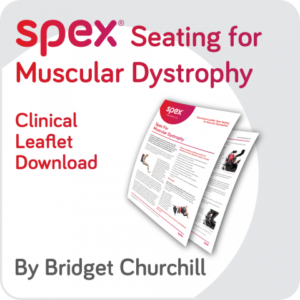Muscular dystrophies are genetic disorders that result in progressive degeneration of the muscles. Muscular dystrophies affect the proximal muscle groups first, which includes those at the hips, spine, shoulders, pelvis, face and neck causing weakness and postural instability.
Muscular dystrophies affect the proximal muscle groups first, which includes those at the hips, spine, shoulders, pelvis, face and neck causing weakness and postural instability.
Additional muscle groups are later affected. There are various types of muscular dystrophies and the majority present in childhood, becoming evident in early childhood years. Some can present in adolescence or early adulthood.
Typical spinal changes that can occur include lordosis, sway back and kyphosis. Most individuals with muscular dystrophies will develop scoliosis of the spine which further impacts on breathing, gastrointestinal functioning, postural control and functional ability(Mercuri & Muntoni, 2013). Pelvic changes can include obliquity and rotation which can affect, and be affected by, scoliosis.
Muscular dystrophy clients require a coordinated multi-disciplinary team (MDT) approach for assessment, management and treatment to support them as they face the progressive changes associated with these conditions. The conditions can affect growth and development, result in loss of coordination and postural control, cognitive changes and require increased care and mobility support.
Key management areas include diagnosis, maintaining and optimising body functions (cardiac, gastro-intestinal, endocrine and respiratory systems), pain management, fatigue management, spinal scoliosis management, psychosocial support and education to the client and families, rehabilitation and provision of assistive technology to optimise and promote engagement, independence and quality of life (Birnkrant, 2018; Birnkrant et al., 2018; Pandya, King, & Tawil, 2008).
When considering seating provision for individuals, the key elements need to include:
- Supporting the body to maintain a healthy alignment against gravity at the hips, trunk, and head.
- Adequate support to the pelvis and trunk to provide stability.
- Providing appropriate pressure relief.
- Providing support to minimise fatigue.
- Facilitate engagement in functional activities.
- Allow for adjustment and adaptation as needs change.
- Be easy to use by client and family/carers.
- Be aesthetically pleasing and allow for self-expression.
- Provide comfort.
- Optimise posture for cardiac, respiratory and gastrointestinal function.
Spex seating is a versatile, adjustable modular system that can be fixed onto almost any wheelchair chassis. It can be easily transported. There are paediatric, kids and adult seating technology ranges that can grow and adapt to the users’ needs as they grow and experience changing needs.
Spex is customisable to reflect personal colour choice, quick to adjust and includes the ability to support complex postures. Users only need order what they need and can add/remove components as their condition changes.

Spex shapes better lives and never overshadows the user!
The BINGO Spex provides the seating technology with the BINGO OT stroller- base. This product is suitable for those who become symptomatic around 3-5 years of age.
become symptomatic around 3-5 years of age.
The BINGO Spex allows shaping within the back support and seat cushion to provide optimal support to a young child who may be demonstrating some of the musculoskeletal changes that occur with Muscular Dystrophies.
The child remains the focus when seated in the chair, whilst posture is well supported. Adjustments can be easily made as the child grows and as needs change.
Spex Seating Technology Products
Spex for kids and adults is a modular seating technology system which includes cushions, hip supports, trunk supports, knee/thigh supports, head and arm supports, a variety of accessories, and back supports that can allow for easy adjustment and contouring for those with spinal scoliosis, lordosis and kyphosis and complex postural presentations.
supports, knee/thigh supports, head and arm supports, a variety of accessories, and back supports that can allow for easy adjustment and contouring for those with spinal scoliosis, lordosis and kyphosis and complex postural presentations.
Items can be used in isolation or as a full seating system on their chosen wheelchair chassis base.
The Spex contour cushions can be shaped to the users pelvic and thigh alignment to promote stability, comfort and pressure relief. The trunk, hip and medial thigh/knee supports included patented axial technology that can respond to the user’s unique postural presentation and support needs to be appropriately positioned for optimal stability, promoting of function and management of secondary complications.
Spex Flex cushion is designed to provide a stable base for those clients with a fixed hip asymmetry and obliquity. The trunk, hip and medial thigh/knee supports included patented axial technology that can respond to the user’s unique postural presentation and support needs to be appropriately positioned for optimal stability, promoting of function and management of secondary complications.
The head supports provide optimal head alignment to encourage interaction, manage fatigue and pain and promote continued engagement in activities.
The more supportive Spex and Spex SuperShape are versatile back supports that respond quickly (with easy adjustment) to spinal surgical and postural changes and allow greater immersion, pressure distribution and support for those with marked asymmetry and complexity.
Adjustments do not require specialist wheelchair clinics but can be done by locally trained therapists to optimise comfort and postural responsiveness to the users’ needs.
Contact us to:
- Arrange clinical education on our products in your venue of choice, or
- Obtain information about your local dealer for sales enquiries if outside of New Zealand & Australia.
Birnkrant, D. J. (2018). Diagnosis and manage-ment of Duchenne muscular dystrophy, part 1: diagnosis, and neuromuscular, rehabilitation, endocrine, and gastrointestinal and nutritional management. Lancet Neurology, 17(3), 251–267.
Birnkrant, D. J., Bushby, K., Bann, C. M., Alman, B. A., Apkon, S. D., Blackwell, A., … Ward, L. M. (2018). Diagnosis and management of Duchenne muscular dystrophy, part 2: respiratory, cardiac, bone health, and orthopaedic management. The Lancet Neurology, 17(4), 347–361. https://doi.org/10.1016/S1474-4422(18)30025-5
Mercuri, E., & Muntoni, F. (2013). Muscular dystrophies. The Lancet, 381(9869), 845–860. https://doi.org/10.1016/S0140-6736(12)61897-2
Pandya, S., King, W. M., & Tawil, R. (2008). Facioscapulohumeral Dystrophy. Physical Therapy, 88(1), 10.
















